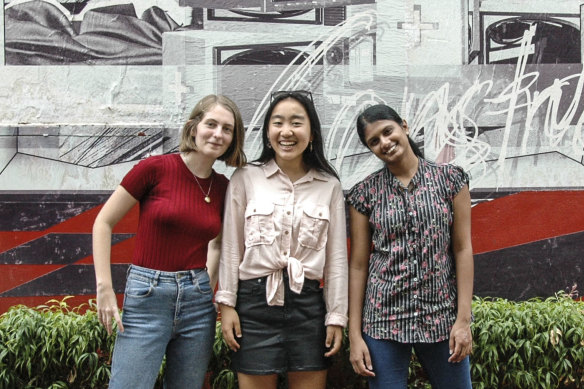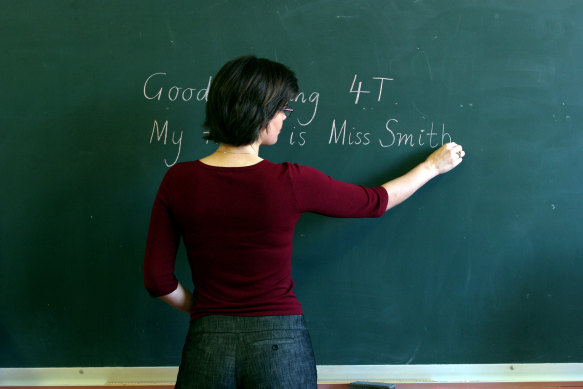This was published 1 year ago
Opinion
Unpaid internships are one thing, but paying to work? That’s absurd
Millie Muroi
Economics WriterWhat if I told you people are paying to work? Yes, you read that right, and we need to talk about it.
The most recent school term has been educational for me and exhausting for my flatmate – and not because we have kids. Some days, she would be fast asleep by the time I got home.
Five days a week, for roughly eight hours a day, she’s been working: planning and delivering lessons for dozens of five-year-olds, marking schoolwork and filling in for teachers when they fall sick. The catch? She hasn’t been paid a single cent.

Education student Talica Gummery, Millie Muroi and medical student Amulya Nallanchakravartula.
That’s because she’s one of hundreds of thousands of Australians enrolled in a university course which requires students to complete unpaid placements. These placements – in education, nursing, medicine, social work, psychology and more – are not just CV stackers. For these students, they are compulsory.
My flatmate has racked up roughly 400 hours for her primary school teaching degree, most of it over the past nine weeks. It left me with little doubt that placements are tough, especially for university students who don’t have substantial savings or family support.
The financial stress on these students has a name: placement poverty.
Unpaid placements have been around for decades. But recent cost-of-living pressures have put a huge burden on one of our most vulnerable demographics.
When our rent increased by more than 30 per cent earlier this year, my flatmate and I agreed I would cover a majority of the increase until she finished her placement. Not everyone has that flexibility.

Compulsory placements are part of teacher training but they often involve real work for no pay.Credit: Cathryn Tremain
Another friend is completing her placement in the Queensland city of Bundaberg (yes, where the brewing company is based), as part of her medicine degree. Like my flatmate, she’s on youth allowance – financial help for young people studying or looking for work – but said without parental support, she would probably fall short.
Some universities provide a bit of assistance through bursaries or rental assistance, especially for regional placements. But it’s often a limited pool of money.
To paint the picture, for someone living away from home (with no children), the maximum weekly youth allowance is roughly $320. The maximum rent subsidy is $94 a week.
Meanwhile, median weekly rent for apartments across the capital cities has climbed to $620, and as high as $700 in Sydney. Even if we assume $620 is split between two people, that’s $310 a week in rent alone, leaving just over $100 a week. If groceries cost $100 a week, that’s all of that income gone. Need to get to the placement? I guess you can always walk.
Then there’s still other essential spending including energy bills, internet, insurance, and more.

Medical and nursing students are often expected to complete unpaid internships as part of their study.Credit: iStockphoto
No wonder 70 per cent of full-time tertiary students were employed as of February this year (an increase from 55 per cent at the same time in 2016). Without working, it’s nearly impossible to get by without additional support. There’s not much to draw from the piggy bank either. The median savings of those aged 18-24 is less than $3000.
While my Bundaberg friend works roughly eight hours a day, she’s expected to be free between 7am and 10pm to attend other learning events. And like my housemate, she’s still required to do course work during placement.
Full-time work, full-time study and holding on to a part-time job requires superhuman powers.
About a third of students said they lost their entire weekly income because of a placement according to one survey in 2022. And 80 per cent of students reported their mental health had been negatively affected because of the financial hardship associated with their placement.
This stress (or burnout), especially for those who have no family support, makes it incredibly difficult to focus on the entire point of the placement: learning. Some drop out of courses because of the financial stress they are put under during these placements.
It’s absurd that students are essentially paying to work (through their university fees), and in most cases, scrambling to keep up with living costs because they can no longer work their paid job.
From a fairness perspective, we need to make sure we’re not creating barriers for students from low socioeconomic backgrounds in fields such as medicine where they are already underrepresented.
And let’s think about parents who may be looking to rejoin the workforce after having kids. These people, especially in a partnered household, already face costly trade-offs including losing tax benefits when returning to work. We need to make it easier for these people to reskill. That includes making sure qualifications they need to complete don’t end up pushing them into poverty.
This all comes at a time when we’re facing shortages in professions such as nursing and education. If we want the best chance at attracting students to these courses, and making sure they complete them, we need to make sure they have enough income to focus and survive.
There’s an argument for paying at least minimum wage to students on placement. Many, including my friends, are readily being used to plug the gaps appearing in our hospitals and schools. At the very least, the government needs to allow some of the most vulnerable students to apply to receive a temporary payment while they are on placement.
If we don’t cough up to support the most vulnerable students, our hospitals and schools will suffer, and we’ll be left worse off. I hope things change long before those five-year olds at my flatmate’s placement find themselves at the front of the classroom.
Millie Muroi is a business reporter.
Get a weekly wrap of views that will challenge, champion and inform your own. Sign up for our Opinion newsletter.